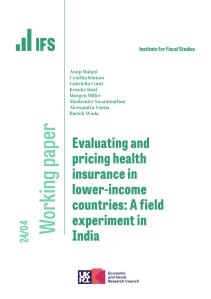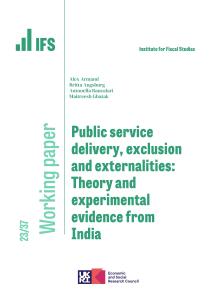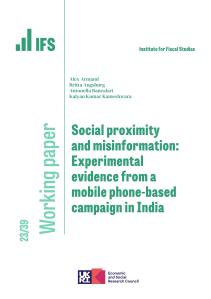Labeled microcredit loans increase the take-up of safe toilets, but take-up and conversion are influenced by intra-household gender differences in perceptions and bargaining power.
Editor’s note: Today marks World Water Day – a day to focus on accelerating change to solve the water and sanitation crisis.
There are currently 3.6 billion people, mostly in low- and middle-income countries, either using unsafe sanitation infrastructure, or not using this infrastructure at all. The unsafe disposal of human feces is a global problem – more than 80% of the world’s sewage is discharged untreated into the environment. High rates of such contamination worsen health (Augsburg and Rodriguez-Lesmes 2018, Dickinson et al. 2015, Kumar and Vollmer 2013, Pickering et al. 2015, Spears 2020) and increase psycho-social stress (Sahoo et al. 2015), leading to worse human capital outcomes (Spears and Lamba 2015) and constrained economic growth (WSP 2011).
There are currently 3.6 billion people, mostly in low- and middle-income countries, either using unsafe sanitation infrastructure, or not using this infrastructure at all. The unsafe disposal of human feces is a global problem – more than 80% of the world’s sewage is discharged untreated into the environment. High rates of such contamination worsen health (Augsburg and Rodriguez-Lesmes 2018, Dickinson et al. 2015, Kumar and Vollmer 2013, Pickering et al. 2015, Spears 2020) and increase psycho-social stress (Sahoo et al. 2015), leading to worse human capital outcomes (Spears and Lamba 2015) and constrained economic growth (WSP 2011).
Sanitation investments are complex and expensive
In two contributions to a special issue on sanitation and development in the Journal of Development Economics, we have studied household constraints in the adoption of safe sanitation infrastructure and behaviour (Augsburg et al. 2023a, Augsburg et al. 2023b). Investing in a toilet is a significant, lumpy outlay: in our study context – rural Maharashtra, India – the average reported real cost of existing toilets accounted for over 50% of average household annual income. Even when perceived benefits outweigh these costs, liquidity constraints hamper investment: the vast majority of households across varying contexts reported financing constraints as the key impediment to investing in sanitation.
Figure 1: Toilets are too expensive!
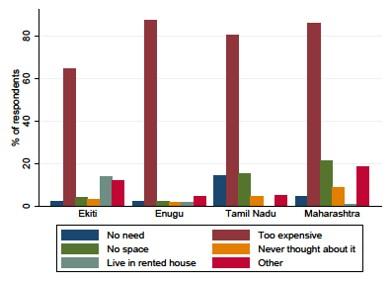
Source: Reproduced from figure 2 of Augsburg et al. (2015).
Microfinance as an accelerator to solve the sanitation crisis
With increasing access to microcredit amongst the poor in developing countries, this has been proposed as a potential solution to alleviate liquidity constraints by providing access to a collateral-free, up-front lump sum which can be repaid over time (Cull and Morduch 2018). In one of our contributions (Augsburg et al. 2023a), we show through a randomized controlled trial that providing microcredit loans labeled for sanitation is an effective approach to motivate toilet construction. Two-and-a-half years after the intervention was rolled out, 18% of eligible clients had taken a sanitation loan, resulting in a 9 percentage point increase in toilet ownership and a 10 percentage point reduction in open defecation. The impact on toilet uptake is within the range achieved by other sanitation interventions, which range from no effect of a latrine promotion programme in Bangladesh studied by Guiteras et al. (2015) to a 19 percentage point increase in Madhya Pradesh, India, studied by Patil et al. (2014). We also document that at endline, almost all sanitation loans had been repaid or were on track to be repaid by the end of the loan cycle.
Figure 2: Impacts on loan and toilet uptake over the course of the experiment
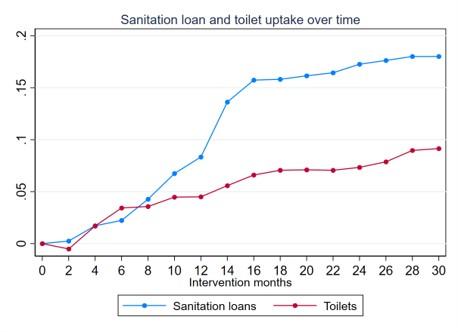
Importantly, we show in the paper that it is not just the provision of additional credit that matters for households’ sanitation investment decisions, but that the label attached to the credit plays a key role. It is by now well established that credit design features such as collateral (Jack et al. 2018), liability structure (Attanasio et al. 2015) and grace period (Field et al. 2013) influence investment decisions. The novelty of our study is to show that the loan label – a ubiquitous though understudied feature of microcredit – plays a significant role in affecting loan take-up and investment decisions of poor households. The label may provide an implicit commitment incentive through mental accounting (Thaler 1990), or borrowers’ (or their peers’) perceptions of loan use enforcement or reputation building with the lender.
Moreover, we show that the loan, implemented during the roll-out of India’s Swachh Bharat Mission (SBM) policy, helped SBM in its goal of eliminating open defecation by alleviating liquidity constraints for households ineligible for post-construction SBM subsidies. It also provided bridge funding and top-up funding for subsidy-eligible households to finance the up-front cost of construction. However, delays in receiving subsidies and higher-than-expected costs led to an abandonment of sanitation investment intentions, leading to non-conversion of some loans to toilets.
Microcredit relative to other sanitation policies
This research has important implications for the design of sanitation policies. Concerns have been raised about the costs and effectiveness of two widely used approaches: Community-Led Total Sanitation (CLTS), which mobilizes communities and creates awareness about sanitation issues, and the provision of subsidies. While each of these policies has been shown to be effective, individually and when combined (e.g. Clasen et al. 2014, Guiteras et al. 2015, Patil et al. 2014, Pickering et al. 2015), they can be very costly, and difficult to target effectively. By contrast, conditional on sufficiently high repayment rates, labeled microcredit loans offer an alternative, lower-cost approach (to providers) to increasing sanitation investments.
Perceptions of sanitation investment returns and costs matter, including for intervention design
In the second paper (Augsburg et al. 2023b), we further unpack a household’s sanitation investment decision-making process, and focus on the roles of intra-household gender differences in perceptions of the investment and bargaining power.
First, we exploit data which documents perceptions of costs and benefits of sanitation, by gender and within the same household, providing several novel insights. We confirm the general assumption that women, on average, perceive higher benefits of owning a toilet. However, we also uncover significant variation in benefit perceptions by gender and within households. In 30% of households, men perceive a higher benefit of a toilet model desired by households in this context than women. We also document similar variation in within-household perceptions of monetary and non-monetary costs. Interestingly, the data show that men and women both often overestimate the monetary costs of the toilet.
Figure 3: Perceptions of sanitation benefits
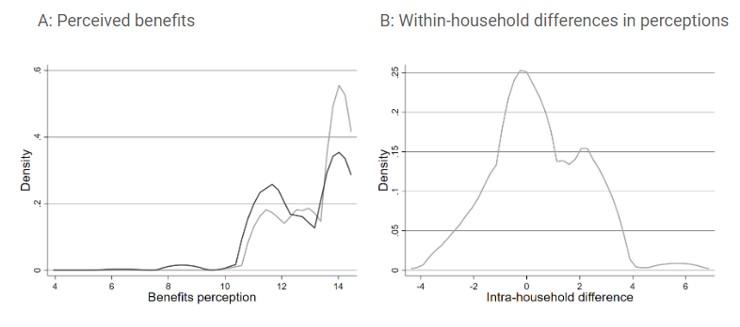
We find that within-household differences in perceptions of benefits influence the take-up of sanitation loans, whereas within-household differences in perceptions of costs – in particular monetary costs – influence whether a loan is successfully converted to a new toilet. Households where the woman perceives a lower benefit to sanitation than the man are almost four times less likely to take the loan and households where the woman perceives a lower monetary cost than the man are more likely to invest in a toilet than others.
We then assess how bargaining power, alongside these within-household differences in perceptions, affects take-up of the sanitation loan and sanitation investments, and hence the success of the sanitation loan programme. We demonstrate that in households where the woman is not involved in decision-making, the intra-household differences in perceptions do not influence intervention impacts on loan uptake or sanitation investments. Thus, it is only when the woman has a say in household decisions that her perceptions matter, and affect household borrowing and sanitation investment responses to the sanitation loan intervention.
Key policy takeaways
These findings provide important nuances for the design of a sanitation microcredit product, and indeed sanitation interventions more generally. Targeting sanitation to women – as frequently done – can be effective in spurring sanitation investments, especially in households where women have relatively moderate bargaining power and higher net perceived benefits than their spouses. However, effective policies should (i) seek to engage with men, while also seeking to encourage the involvement of women in decision-making processes, and (ii) disseminate information not just on benefits of an investment but also on costs. Community-Led Total Sanitation, the most common policy adopted by more than 25 governments around the world (Zuin et al. 2019), mainly highlights the benefits of toilets. However, our results suggest that there are significant misperceptions about monetary costs, and that these have an especially important influence in ensuring that financial resources earmarked for sanitation investments result in new toilets.
References
Attanasio, O, B Augsburg, R De Haas, E Fitzsimons, and H Harmgart (2015), “The impacts of microfinance: Evidence from joint-liability lending in Mongolia.” American Economic Journal: Applied Economics 7(1): 90–122.
Augsburg, B and P A Rodriguez-Lesmes (2018), “Sanitation and child health in India.” World Development 107: 22–39.
Augsburg, B, B Caeyers and F Oteiza (2015), “The costs and benefits of investing in a toilet.” Available here.
Augsburg, B, B Caeyers, S Giunti, B Malde and S Smets (2023a), “Labeled loans and human capital investments.” Journal of Development Economics 162: 103053.
Augsburg, B, B Malde, H Olorenshaw and Z Wahhaj (2023b), „To invest or not to invest in sanitation: The role of intra-household gender differences in perceptions and bargaining power”, Journal of Development Economics 162: 103074.
Clasen, T, S Boisson, P Routray, B Torondel, M Bell, O Cumming, J Ensink, M Freeman, M Jenkins, M Odagiri, S Ray, A Sinha, M Suar and W P Schmidt (2014), “Effectiveness of a rural sanitation programme on diarrhoea, soil-transmitted helminth infection and child malnutrition in Odisha, India: A cluster-randomised trial.” Lancet Global Health 2: 645–653.
Cull, R, and J Morduch (2018), “Microfinance and economic development.” In: Handbook of Finance and Development. Edward Elgar Publishing.
Dickinson, K L, S R Patil, S K Pattanayak, C Poulos and J H Yang (2015), “Nature’s call: Impacts of sanitation choices in Orissa, India.” Economic Development and Cultural Change 64(1): 1–29.
Field, E, R Pande, J Papp, and N Rigol (2013), “Does the classic microfinance model discourage entrepreneurship among the poor? Experimental evidence from India.” American Economic Review 103(3): 2196–226.
Guiteras, R, J Levinsohn, A M Mobarak (2015), “Encouraging sanitation investment in the developing world: A cluster-randomized trial.” Science 348(6237), 903–6.
Jack, W, M Kremer, J de Laat and T Suri (2018), “Borrowing requirements, credit access, and adverse selection: Evidence from Kenya.” Available here.
Kumar, S and S Vollmer (2013), “Does access to improved sanitation reduce childhood diarrhoea in rural India?” Health Economics 22(4): 410–27.
Patil, S R, B F Arnold, A L Salvatore, B Briceno, S Ganguly, J M Colford and P J Gertler (2014), “The effect of India’s Total Sanitation Campaign on defecation behaviors and child health in rural Madhya Pradesh: A cluster randomized controlled trial.” PLoS Med 11(8): e1001709.
Pickering, A, H Djebbari, C Lopez, M Coulibaly, and M L Alzua (2015), “Effect of a community-led sanitation intervention on child diarrhoea and child growth in rural Mali: A cluster-randomised controlled trial.” Lancet Global Health 3(11): 701–11.
Sahoo, K C, K R S Hulland, B A Caruso, R Swain, M C Freeman, P Panigrahi, and R Dreibelbis (2015), “Sanitation-related psychosocial stress: A grounded theory study of women across the life-course in Odisha, India”. Social Science Medicine 139: 80–9.
Spears, D (2020), “Exposure to open defecation can account for the Indian enigma of child height.” Journal of Development Economics 146: 102277.
Spears, D and S Lamba, (2015), “Effects of early-life exposure to sanitation on childhood cognitive skills: Evidence from India’s Total Sanitation Campaign.” Journal of Human Resources 51: 298–327.
Thaler, R H (1990), “Anomalies: Saving, fungibility, and mental accounts.” Journal of Economic Perspectives 4: 193–205.
WSP (2011), “Economic Impacts of Inadequate Sanitation in India.”
Zuin, V, C Delaire, R Peletz, A Cock-Esteb, R Khush, and J Albert (2019), “Policy diffusion in the rural sanitation sector: Lessons from Community-Led Total Sanitation (CLTS).” World Development 124: 104643.












